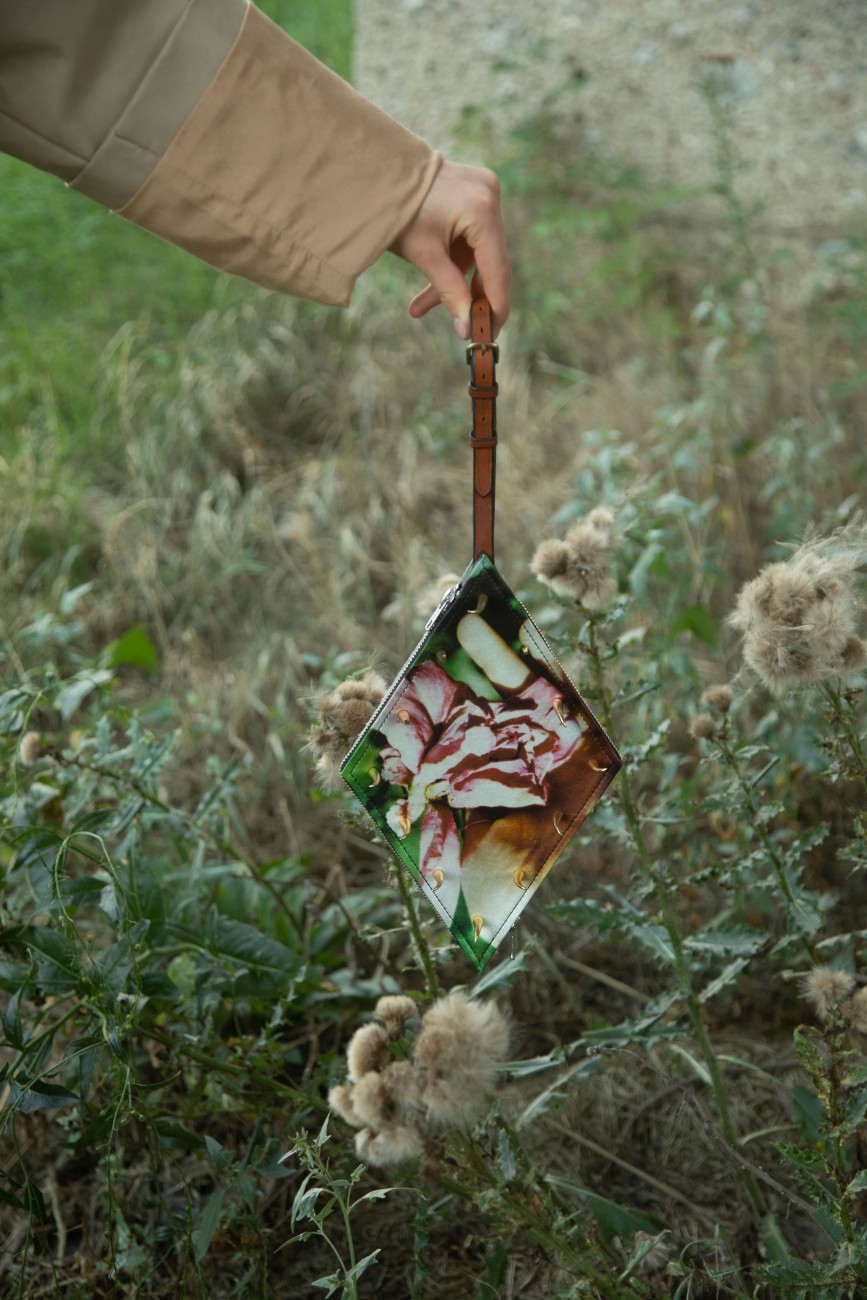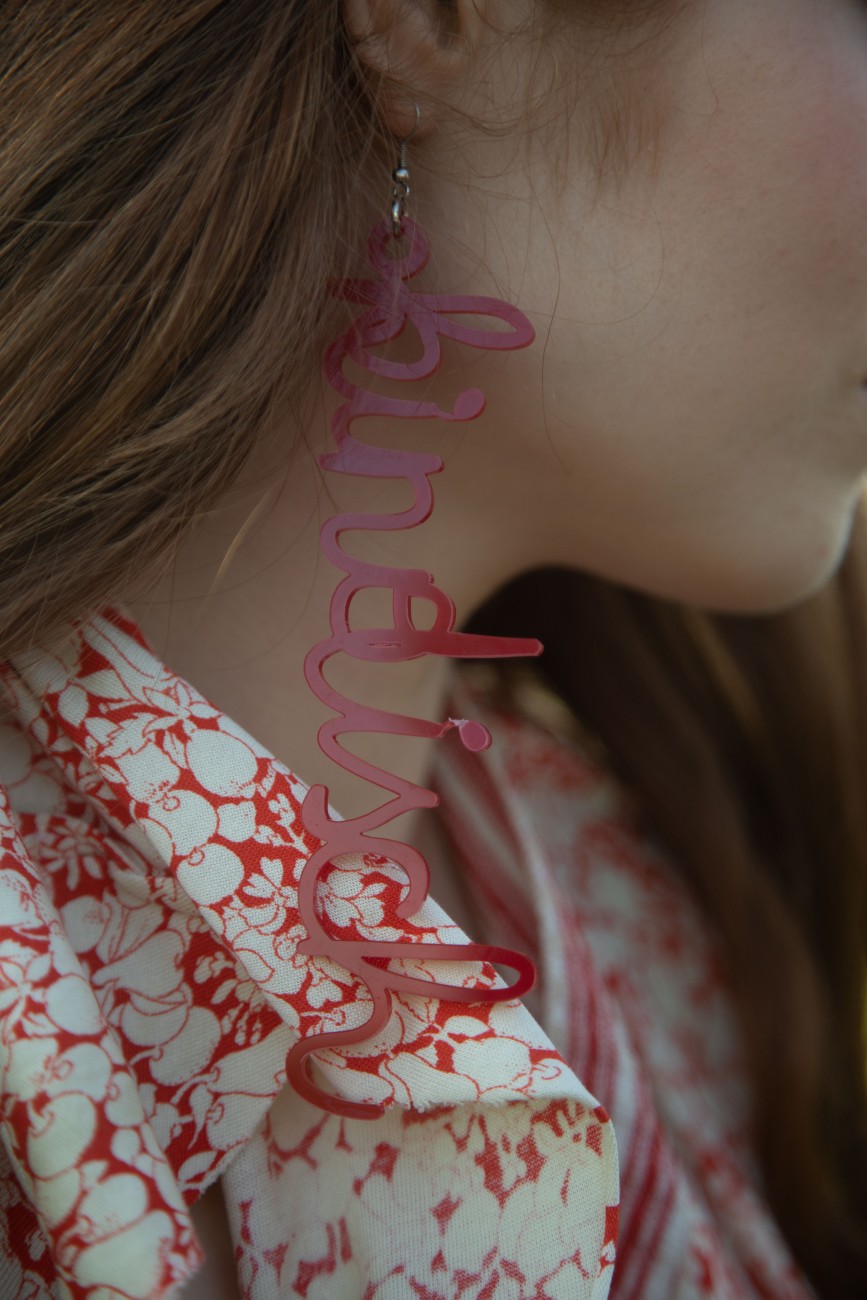Currently studying MA Cultural Anthropology and Environmental Humanities at LMU Munich, 25-year-old Carolina Schmidt has always been compelled to creativity. Whether that’s composing music on the piano, envisioning films or experimenting with new media. As the younger sister of one of our Œ family members, Hanna Schmidt, we have had the pleasure of watching Carolina’s artistic talents blossom over the years, which is why we are proud to present her most recent film Green Desert (2022).
Green Desert (Grüne Wüste in German) was part of Carolina’s final project of her BA in filmmaking. This short, dream-like film unwinds over lush green hills in the Austrian countryside. It follows the everyday encounters of a young red-headed woman, magnifying the theme of identity, and the questions that surround it: Who are we? What are we made up of? Who is part of our lives? Why and when do we become connected – or disconnected – from them?
For this article, we spoke to director Carolina and stylist Hanna about the journey of creating Green Desert, its inspirations and how we can use fashion as a medium to portray identity in visual art. A trailer of the film is available to watch below.
Œ: How long have you been working on the film? Where did it all begin?
Carolina: I think in total I worked on this film for one year. The start was quite challenging, sitting at my desk at home, sketching and writing ideas not knowing if they would make sense to anyone. I guess that was the beginning of it all, it just started with a sketchbook and some doubts. The more I just stuck to these ideas and trusted my intuition, the more others began following me and this was when I started to get excited about the project. I am lucky to have worked with such a great team that worked hard to make this strange film happen and I’d recommend them to anyone. It was wonderful having Georg Papadelis as a DoP on Board, we soon developed a mutual vision for the film.
Œ: How would you describe your film? Who/what inspired you?
Carolina: In Green Desert, we see the main character embarking on a contemplative journey, walking through vast landscapes and encountering people going about their daily lives – painting, thinking, walking, sitting around, and working. I wanted to capture the current feeling many of us share – many crises are posing existential questions, making us rethink the lives we live, who we are, our (dis-) connection to work, others, our routines, and daily life.
The films by Béla Tarr, Andrei Tarkovsky, Ingmar Bergman, Tsai Ming-Liang, Abbas Kiarostami, Chantal Akerman and more are films are very personal to me, they inspired and encouraged me to express myself in a movie like Green Desert, asking big questions slowly and playfully. I am particularly interested in the magic of everyday life – the mundane, the seemingly normal, the routines, and the small things. They reflect the myths we tell ourselves about the world, life, and ‘nature’ – questioning them can be powerful. Green Desert is never complete without the viewer – the audience is a fundamental part of this film.


Œ: How different/similar is it to what you initially conceptualised?
Carolina: Hurdles can be a great thing when shooting a film. They force you to quickly find a new idea and sometimes it turns out that this idea might actually be more interesting than what you originally envisioned. So some things definitely changed but I’m glad they did!
Œ: Walk me through your casting process – what made it unique? And what would you do differently next time?
Carolina: As I was wandering through the landscapes of the film, I knew I wanted people in it who have a relationship with each location. For example, in one scene we see a landscape painter next to a bridge. I had hung up hand-written casting calls at that bridge and one day a guy, his name is Hiwa Naqshi, call me and said he was interested. He happened to be an actual painter trained at an art academy in Iran and he saw the casting call as he was walking through the bridge. The bridge is located in a very remote area and I am really lucky we found each other!
What I’d do differently next time? I love this approach of casting people but it needs a lot of time. So, I would plan a lot more time to be able to find the right people near the locations.


RIGHT
Outfit – Larissa Falk
Œ: The location is so dreamy! Where was it shot? Why was this location special for you?
Carolina: At a way too young age I watched Gus Van Sant’s “Gerry” and that film stuck with me ever since. I loved how the locations played a huge role in the dramaturgy of the film and it inspired me a lot although the landscapes of the US and Argentina look a little bit different from those of the outskirts of Salzburg. So I was mainly guided by a certain feeling that Gus Van Sant’s film gave me. Mountains didn’t fit the aesthetic and the idea of the film so it was hard finding the right spots near Salzburg. However, I found some very unique places and I wouldn’t want to have shot my film anywhere else. I felt a strong connection to these locations, I spent hours there just looking at them and the people in them.
Œ: One of your many talents is pianism – in fact, the music in this film is actually yours! What came first the visual or audio content? How did they mould one another?
Carolina: I composed the music after the filming. It’s almost like images made the music – I just kept replaying the scenes over and over again while improvising on the piano. Then I would forget about it and a week later, I just improvised again. I repeated that process and over time, a pattern emerges – some themes keep coming back and it all just comes together naturally. Then, I move to Ableton and experiment with that based on these compositions.
However, music influenced the images too. While I was writing the film I was listening to a lot of music, especially to Meredith Monk. Sometimes ideas also came up while making music.


LEFT
Earings – Elisabeth von der Tannen
Red dress – Céline van de Loo
RIGHT
Stockings – Jasmin Erb
Œ: Hanna, you’ve worked as one of our Fashion Editors for a few years now. In turn, you’ve become well-acquainted with a rich pool of Berlin-based talent. How did you go about selecting designers for this film?
Hanna: Except for Julia Ballardt, who is a designer based in Antwerp and Larissa Falk from Austria, Celine van de Loo and Jasmin Erb are from Berlin, that’s true.
I wanted to bring a sensual, poetic touch into the costume and looked around at what students from the big academies were doing at the moment that could fit the story. I like to collaborate with fresh young design talents as it is what they are creating that often will be everywhere one year after. Also, it resonates with the platform Πwants to offer.
Œ: Identity is the core theme of the film. How have you used clothing to help us understand the protagonist’s identity?
Hanna: She is on a journey of self-discovery through bizarre symbolic fields of uncertainty, transition and ambiguity. So I contrasted this playful, Alice in wonderland reminiscent dress with the more mature trench. Although it still has some playful aspects left through its flowing patchwork details.


Œ: For those interested in watching the full film, where can they find it?
Carolina: Currently, the film is being shown at festivals and people can stay updated about current screenings here. Once the festival season is over the film will be made available online.
Œ: Where has the film been presented so far? Has it been well received?
Carolina: It’s been pretty busy so far! In September, it was shown at the Tetova International Film Festival in North Macedonia as part of the Win Panorama Competition. Then, last month, it was screened at Lima Alterna International Film Festival in Peru, which focuses on alternative, independent and auteur cinema from all over the world. I found their programme really intriguing! For the duration of the festival, Green Desert was made available on the streaming platform called Cineaparte, which is the main online library for Peruvian Cinema.
Oh, and we also won Best Experimental Film at the Austrian Film Festival two weeks ago, which was really nice. Apart from that, Green Desert was selected for the 16th Fünf Seen Film Festival in Germany, the 11th Alexandre Trauner Film Festival in Hungary, and the 14th Sarajevo Omladinski Film Festival in Bosnia and Herzegovina. There will also be some non-competitive film screenings.


Œ: Although this wasn’t your first film, did you manage to learn anything new in the process that you haven’t before?
Carolina: It’s not my first film, no. However, it was my first film where I really took some artistic risks and didn’t know whether it will work. Whatever social or institutional context you find yourself in, you’re probably always going to be confronted with expectations and ideals of how a film should be made. I think what I’ve learned is: to value your own ideas! Try them out – the result might not be perfect but it will be honest.
Œ: What’s next on the agenda for you?
Carolina: Since I am half German, half Peruvian, as part of my Master’s degree, I am planning a short documentary in Lima, Peru in 2022 that will also have some of the surreal and slow elements that Green Desert also embodied. I also just arrived back from Tbilisi, Georgia for a university short course. I’ve met a lot of great artists and filmmakers here. I also learned a lot about Georgian film history, which definitely inspired me a lot and will probably inspire my future works.
Credits
Director, Screenplay and Production
Carolina Schmidt
Photography
Anna Hadaier and Julia Kressirer
1st Assistant Camera
Thomas Brunner
2nd Assistant Camera
Anna Hadaier
Gaffer
Christoph Platzer and Ahmed Issa
Set-Design
Julia Kressirer and Magdalena Umkehrer
Styling
Hanna Schmidt
Make-up
Xenia Stütz-Pribik
Hair Stylist
Sebastian Schönefeld
Production Assistants
Sarah Friedl and David Graudenz
Catering
Theresa Klotz
Unit Manager
Julia Kressirer and Simone Kaltenbrunner
VFX Artist
Eugenia Goffre
Music
Carolina Schmidt
Sound Postproduction
Florian Schaubmeier
cast
Elsa Böhm at MIRRRS Models, Katharina Unger, Hiwa Naqshi, Margit Bischlager, Tyler & Julien Tikeli, Thomas Könnecke, Christian Bergler, Magdalena Umkehrer, Winfried Kurzeder, Andrea Behrens, Antonia Behrens, Julia Plank, Anna Stadler, Arthur Fuchs, Rolf Kassalicky
stilt artists
ZEBRA Stelzentheater
supported by
University of Applied Sciences, Salzburg
Fashion
Trench coat, strappy shoes and bag – Julia Ballardt
Red dress – Céline van de Loo
Outfit on singer with yellow embellishments – Larissa Falk
Stockings – Jasmin Erb
Earrings – Elisabeth von der Tannen
White dress – Esther Helin Bienroth
Boots – Stylist’s own






